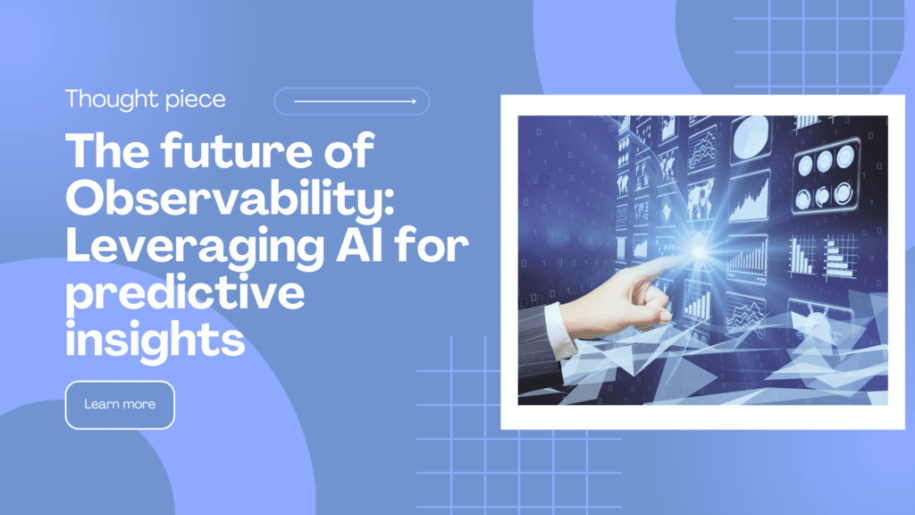The future of Observability: Leveraging AI for predictive Insights
In the digital age, where businesses increasingly rely on complex technological ecosystems, maintaining seamless operations and preemptively addressing issues has become a cornerstone of competitive advantage. Observability, the practice of monitoring and understanding the state of systems, has evolved significantly with the advent of artificial intelligence (AI). This thought piece explores the transformative impact of AI-powered predictive insights on observability, highlighting its key benefits, operational mechanisms, and future trends.
Introduction: The role of AI in observability
As systems grow more intricate and data volumes soar, traditional monitoring techniques fall short of providing the depth and speed of insights required. AI enhances observability by enabling real-time data analysis, anomaly detection, and predictive analytics. AI-driven observability tools sift through vast amounts of data to identify patterns and irregularities that would be impossible for humans to detect manually. This shift improves system reliability and empowers organizations to make informed, proactive decisions.
Key benefits: Predictive analytics, automated responses, deeper data insights
Predictive analytics: One of the most significant advantages of AI in observability is predictive analytics. By analyzing historical data, AI models can forecast potential issues before they manifest into critical problems. This foresight allows teams to address vulnerabilities proactively, reducing downtime and enhancing system stability.
Automated responses: AI cannot just predict problems but also automate responses. When anomalies are detected, AI systems can trigger predefined actions to mitigate the issue. This automation speeds up incident response times and minimizes the impact on operations, ensuring business continuity.
Deeper data insights: AI-driven observability tools provide deeper insights into system performance. By continuously analyzing data from various sources, these tools offer a comprehensive view of the system’s health, performance trends, and potential risks. This granular visibility helps organizations optimize their infrastructure and improve overall efficiency.
How it works: AI algorithms, real-time data processing, anomaly detection
AI algorithms: At the heart of AI-powered observability are sophisticated algorithms that process and analyze data. These algorithms are trained on historical data to recognize standard patterns and detect deviations. Machine learning models continuously learn and adapt, improving their accuracy over time.
Real-time data processing: AI-powered observability tools operate in real-time, processing data as it flows through the system. This real-time capability is crucial for identifying and addressing issues promptly, minimizing the window of vulnerability, and reducing the likelihood of significant disruptions.
Anomaly detection: AI excels at anomaly detection, identifying unusual patterns that might indicate potential problems. By flagging these anomalies early, AI enables teams to investigate and resolve issues before they escalate, ensuring smoother operations and improved system reliability.
Impact: Improved system performance, reduced downtime, smarter decisions
The impact of AI on observability is profound. AI-powered tools significantly enhance system performance by providing predictive insights and automating responses. Organizations experience reduced downtime as potential issues are addressed before they become critical. Moreover, AI’s deeper data insights enable smarter decision-making, allowing businesses to optimize their operations, allocate resources more effectively, and drive continuous improvement.
Future trends: AI advancements, integration with other technologies
The future of AI in observability is bright, with continuous advancements on the horizon. As AI technologies evolve, observability tools will become even more sophisticated, offering greater accuracy and deeper insights. Integration with other emerging technologies, such as edge computing and the Internet of Things (IoT), will expand the scope and capabilities of AI-powered observability. These integrations will enable organizations to monitor and manage increasingly complex and distributed systems easily.
Conclusion – The future of Observability
In conclusion, AI-powered predictive insight tools like FusionReactor revolutionize observability, providing unparalleled visibility into system health and performance. The benefits of predictive analytics, automated responses, and deeper data insights are transforming how organizations operate, leading to improved system performance, reduced downtime, and more intelligent decision-making. As AI advances, the future of observability promises even more significant innovations, driving efficiency and resilience in the digital age.
By understanding and leveraging these advancements, organizations can stay ahead of the curve, ensuring their systems are robust, reliable, and ready to meet the challenges of tomorrow.
Get the infographic
For a summary of these insights, download our comprehensive infographic on “The Future of Observability: AI-Powered Predictive Insights.”










